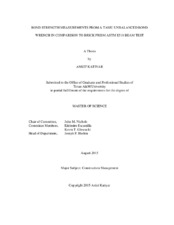| dc.contributor.advisor | Nichols, John M | |
| dc.creator | Katiyar, Ankit | |
| dc.date.accessioned | 2015-10-29T19:43:55Z | |
| dc.date.available | 2015-10-29T19:43:55Z | |
| dc.date.created | 2015-08 | |
| dc.date.issued | 2015-07-24 | |
| dc.date.submitted | August 2015 | |
| dc.identifier.uri | https://hdl.handle.net/1969.1/155535 | |
| dc.description.abstract | The bond strength of the masonry unit is an important characteristic affecting its performance under different loading conditions, including shear and flexural loading. Bond strength of brick masonry is confirmed experimentally using a variety of techniques, including the bond wrench. Four bond wrenches have been built at TAMU over the last five years. In 2010 a lightweight unbalanced and a balanced bond wrench was developed. An Australian Standard Bond Wrench was manufactured in 2011 and in 2012 an ASTM C 1072 Bond Wrench was developed.
Numerous researchers have conducted experiments to study the bias between different bond wrenches. These studies illustrated that no unacceptable bias existed in the flexural strength values calculated using the TAMU balanced and unbalanced wrench. However there existed a bias between American Bond Wrench and Australian Bond wrenches according to research. This thesis aims at understanding the bias between Unbalanced Bond Wrench developed at Texas A&M University and Standard ASTM E518 beam test method.
This experimental research uses Portland cement and a total of 50 prisms was built in two sets. Each prism comprised of six bricks with five joints, and all the bricks used were Texan bricks. The mortar used here was 1:1:6. The samples were cured for a period of 28 days, and all the experiments were carried out under same weather conditions. TAMU Unbalanced Bond Wrench was used to test the first set of prisms and second set of prisms were tested using standard ASTM E518 beam method.
A t-Test analysis was run between the flexural strength values of the TAMU unbalanced wrench and ASTM E518 method. From the plots, it can be inferred that the mean value of the American standard was low when compared with the mean values of the Unbalanced Bond Wrench. The plots of ASTM E518 method and TAMU unbalanced were quite dissimilar.
Further research is recommended using the Texas red brick. | en |
| dc.format.mimetype | application/pdf | |
| dc.language.iso | en | |
| dc.subject | Flexural strength | en |
| dc.subject | Masonry | en |
| dc.subject | ASTM E518 | en |
| dc.subject | TAMU Unbalanced bond wrench | en |
| dc.title | Bond Strength Measurements from a TAMU Unbalanced Bond Wrench in Comparison to Brick Prism ASTM E518 Beam Test | en |
| dc.type | Thesis | en |
| thesis.degree.department | Construction Science | en |
| thesis.degree.discipline | Construction Management | en |
| thesis.degree.grantor | Texas A & M University | en |
| thesis.degree.name | Master of Science | en |
| thesis.degree.level | Masters | en |
| dc.contributor.committeeMember | Escamilla, Edelmiro | |
| dc.contributor.committeeMember | Glowacki, Kevin T. | |
| dc.type.material | text | en |
| dc.date.updated | 2015-10-29T19:43:55Z | |
| local.etdauthor.orcid | 0000-0002-7650-9669 | |


